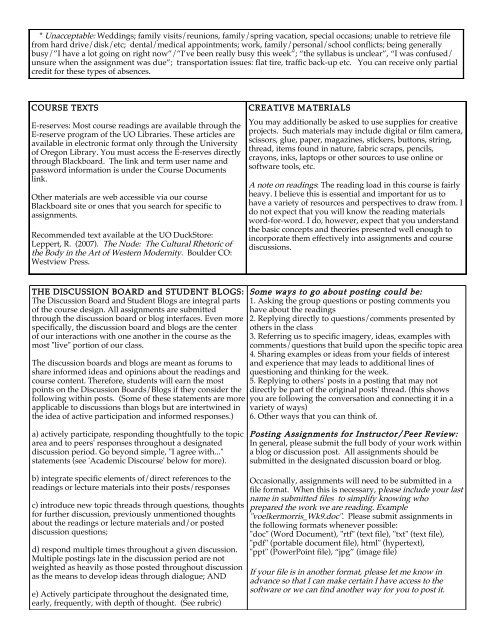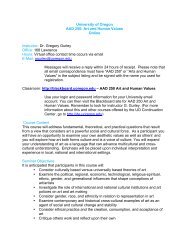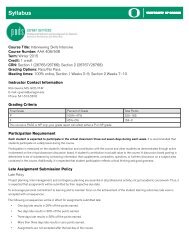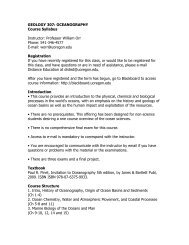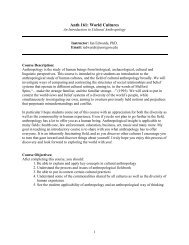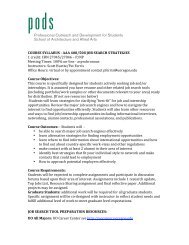Course Syllabus - University of Oregon
Course Syllabus - University of Oregon
Course Syllabus - University of Oregon
You also want an ePaper? Increase the reach of your titles
YUMPU automatically turns print PDFs into web optimized ePapers that Google loves.
* Unacceptable: Weddings; family visits/reunions, family/spring vacation, special occasions; unable to retrieve filefrom hard drive/disk/etc; dental/medical appointments; work, family/personal/school conflicts; being generallybusy/”I have a lot going on right now”/”I’ve been really busy this week”; “the syllabus is unclear”, “I was confused/unsure when the assignment was due”; transportation issues: flat tire, traffic back-up etc. You can receive only partialcredit for these types <strong>of</strong> absences.COURSE TEXTSE-reserves: Most course readings are available through theE-reserve program <strong>of</strong> the UO Libraries. These articles areavailable in electronic format only through the <strong>University</strong><strong>of</strong> <strong>Oregon</strong> Library. You must access the E-reserves directlythrough Blackboard. The link and term user name andpassword information is under the <strong>Course</strong> Documentslink.Other materials are web accessible via our courseBlackboard site or ones that you search for specific toassignments.Recommended text available at the UO DuckStore:Leppert, R. (2007). The Nude: The Cultural Rhetoric <strong>of</strong>the Body in the Art <strong>of</strong> Western Modernity. Boulder CO:Westview Press.CREATIVE MATERIALSYou may additionally be asked to use supplies for creativeprojects. Such materials may include digital or film camera,scissors, glue, paper, magazines, stickers, buttons, string,thread, items found in nature, fabric scraps, pencils,crayons, inks, laptops or other sources to use online ors<strong>of</strong>tware tools, etc.A note on readings: The reading load in this course is fairlyheavy. I believe this is essential and important for us tohave a variety <strong>of</strong> resources and perspectives to draw from. Ido not expect that you will know the reading materialsword-for-word. I do, however, expect that you understandthe basic concepts and theories presented well enough toincorporate them effectively into assignments and coursediscussions.THE DISCUSSION BOARD and STUDENT BLOGS:The Discussion Board and Student Blogs are integral parts<strong>of</strong> the course design. All assignments are submittedthrough the discussion board or blog interfaces. Even morespecifically, the discussion board and blogs are the center<strong>of</strong> our interactions with one another in the course as themost "live" portion <strong>of</strong> our class.The discussion boards and blogs are meant as forums toshare informed ideas and opinions about the readings andcourse content. Therefore, students will earn the mostpoints on the Discussion Boards/Blogs if they consider thefollowing within posts. (Some <strong>of</strong> these statements are moreapplicable to discussions than blogs but are intertwined inthe idea <strong>of</strong> active participation and informed responses.)Some ways to go about posting could be:1. Asking the group questions or posting comments youhave about the readings2. Replying directly to questions/comments presented byothers in the class3. Referring us to specific imagery, ideas, examples withcomments/questions that build upon the specific topic area4. Sharing examples or ideas from your fields <strong>of</strong> interestand experience that may leads to additional lines <strong>of</strong>questioning and thinking for the week.5. Replying to others' posts in a posting that may notdirectly be part <strong>of</strong> the original posts' thread. (this showsyou are following the conversation and connecting it in avariety <strong>of</strong> ways)6. Other ways that you can think <strong>of</strong>.a) actively participate, responding thoughtfully to the topicarea and to peers' responses throughout a designateddiscussion period. Go beyond simple, "I agree with..."statements (see 'Academic Discourse' below for more).b) integrate specific elements <strong>of</strong>/direct references to thereadings or lecture materials into their posts/responsesc) introduce new topic threads through questions, thoughtsfor further discussion, previously unmentioned thoughtsabout the readings or lecture materials and/or posteddiscussion questions;d) respond multiple times throughout a given discussion.Multiple postings late in the discussion period are notweighted as heavily as those posted throughout discussionas the means to develop ideas through dialogue; ANDe) Actively participate throughout the designated time,early, frequently, with depth <strong>of</strong> thought. (See rubric)Posting Assignments for Instructor/Peer Review:In general, please submit the full body <strong>of</strong> your work withina blog or discussion post. All assignments should besubmitted in the designated discussion board or blog.Occasionally, assignments will need to be submitted in afile format. When this is necessary, please include your lastname in submitted files to simplify knowing whoprepared the work we are reading. Example"voelkermorris_Wk9.doc". Please submit assignments inthe following formats whenever possible:"doc" (Word Document), "rtf" (text file), "txt" (text file),"pdf" (portable document file), html" (hypertext),"ppt" (PowerPoint file), “jpg” (image file)If your file is in another format, please let me know inadvance so that I can make certain I have access to thes<strong>of</strong>tware or we can find another way for you to post it.


